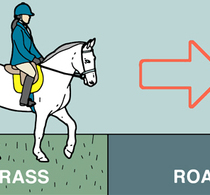
How to avoid equine concussion
Summer can be one of the best times of the year to be a horse owner, but a sudden long, dry spell may not give your horse enough time to adapt to harder ground. The result can be concussion – one of the major factors in horse lameness. We speak to equine physiologist David Marlin for advice on this condition.
Long hacks, shows galore and no need for all that wrapping up are just some of the perks of warmer weather. But when the going underfoot changes from soft to hard in the blink of an eye, it leaves a horse’s body little time to adjust.
What is concussion?
Concussion is part of the force sent up the horse’s leg every time his hoof hits the ground. Fortunately, horses have well-developed coping mechanisms to help with this, but sometimes the forces are more than their bodies can cope with.
Award winning farrier Jim Hayter explains: ‘Everything in the hoof is designed to absorb a certain amount of concussion – from the hoof cartilage to the laminae and the digital cushion. It’s usually when we start asking the horse to run fast on hard ground, trotting too much on the road or generally working them on unsuitable going that things go wrong.’
The risk of concussion-related injuries increases with the horse’s speed and firmness of the ground.
Equine physiologist David Marlin says: ‘The degree of concussive force depends on the rate of deceleration of the foot. Think about a car hitting a wall at 40mph and a car hitting a wall at 5mph – the faster it’s going the greater the damage. In horse terms it’s the difference between galloping and walking.
‘If the wall has a foam covering – i.e. the ground is softer and has some give in it – the damage will be much less,’ he adds.
Muscles, tendons and ligaments in the horse’s legs act like springs to absorb the impact and help push the weight of the horse up again, so fitness and conformation also play an important role.
‘The fitter the horse and the better his conformation, the fewer orthopaedic issues there will be and the more efficiently his body will be able to cope with the effects of concussion,’ explains David.
Petplan expert veterinary expert Gil Riley, adds: ‘Horses are not designed to dissipate concussion, so faults such as upright hind legs and sunken fetlocks will accentuate the problem.’
Five horse concussion symptoms to look out for:
- Heat and swelling: these are the main indicators. Your horse may have soft swelling around the fetlock and/or knee, and warmer feet than usual.
- Being less responsive to the leg: if your horse is feeling the effects of hard ground, he may be less keen to go forward.
- Shorter strides: your horse may lose the swing and spring in his step as he tries to minimise jarring when his feet hit the ground. He may also be reluctant to lengthen his stride.
- Refusing: a previously happy jumper may be reluctant to land after a fence. He might start stopping or running out when he has never done so before.
- Flattening and rushing over a fence: your horse may adjust his technique to prevent him landing so hard.
David shares some actions you can take to help reduce the risk of concussion this summer:
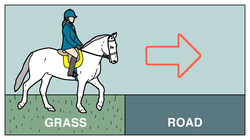
Train on different terrain
When horses spend a lot of time on prepared surfaces, certain natural functions aren’t able to happen. ‘If you plan to go for long rides on variable going, or compete your horse on hard ground, then try to include varied going in your day-to-day work so the horse can become conditioned in the right way. You should always do some training on the type of surface the horse is likely to be exposed to in competition,’ advises David. ‘Working on a combination of different surfaces means you are protecting your horse from injury. Variety, short bursts and constant monitoring are the key.’
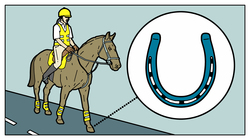
Don’t overdo roadwork
‘Roadwork can play an important role in rehabilitation because the surface is straight and consistent, but if you were to run on the road without wearing good, shock-absorbing running shoes, your feet can get very sore – and it’s the same for horses,’ says David. ‘Steel shoes aren’t great shock absorbers but at the same time this doesn’t mean barefoot horses are not at risk.’
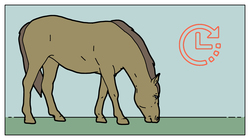
Know your horse
It’s important to consider a horse’s history when planning his work schedule. ‘A 20-year-old horse that suffers from joint issues and gets stiff is not going to benefit from extended periods of trotting on a hard surface,’ points out David. ‘On the other hand, a horse with a history of muscle injuries is going to be at increased risk when working on a very soft surface.’
If the ground isn’t good enough to ride and train your horse on safely, taking a step back for a couple of weeks can reduce the risk of injury and is the better option in the long run.
Gil Riley emphasises the importance of keeping your horse’s weight in check. ‘Overweight horses will be more susceptible to concussion,’ he says. Gil also points out that there is a case to be made for selecting the right horse for the right job. ‘Concussion becomes disproportionately greater the bigger the animal,’ he says. ‘If you try and do endurance with a cob you will likely run into trouble.’
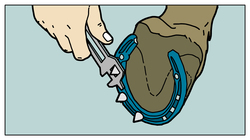
Only use studs when essential
David believes that studs should not be used as a matter of course, but only if the conditions require them. ‘If you watch high speed videos of horses’ hooves hitting the ground you’ll see there’s some degree of sliding. This is part of the normal interaction between the foot and the ground and it minimises the forces being applied. If sliding isn’t allowed to happen (i.e. if the horse is wearing too many studs or studs that are inappropriate), the result can be rapid deceleration. The tendons become loaded and this puts stress on all the structures from the knee downward.’
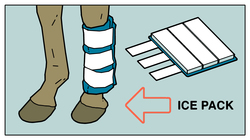
Treating concussion
‘If you suspect your horse may be jarred up it’s not necessarily a reason to panic. First, think back to work you’ve recently done,’ advises David. ‘Have you just done your first real gallop of the season? Has the ground suddenly turned firm? Did you perhaps do a longer spell of fast work than normal?
‘Warm or filled joints are not a normal response to exercise. For this reason – and to prevent further injury – the first thing to do is to back off the workload. Give the horse an easy few days to see if the swelling and heat subside.’
Cold therapy can be very useful in the early stages of concussion. ‘Any acute injury is likely to benefit from cooling and cold treatment. Even if it doesn’t resolve the problem it is unlikely to do any harm,’ says David. ‘On the other hand, heat is not helpful and bandaging the legs will increase inflammation.’
‘If there’s still heat, swelling and/or lameness after a few days of cold therapy and rest, then that is the time to consult your vet.’
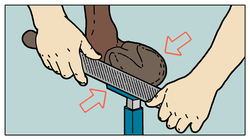
The role of the farrier
Farriers have an important role in reducing the risk of concussion. ‘When we shoe a horse, we try and mimic nature’s way of dealing with the forces being placed on the limbs,’ explains Jim. ‘Every horse is different and it’s important to take into account its conformation, as well as the job it’s doing and how it is performing.
‘Achieving a good foot balance is really important. There are a lot of pads and fillers available to help alleviate concussion, but if the foot is not properly trimmed and the correct balance achieved then fitting anything to a horse’s foot is pointless.’


